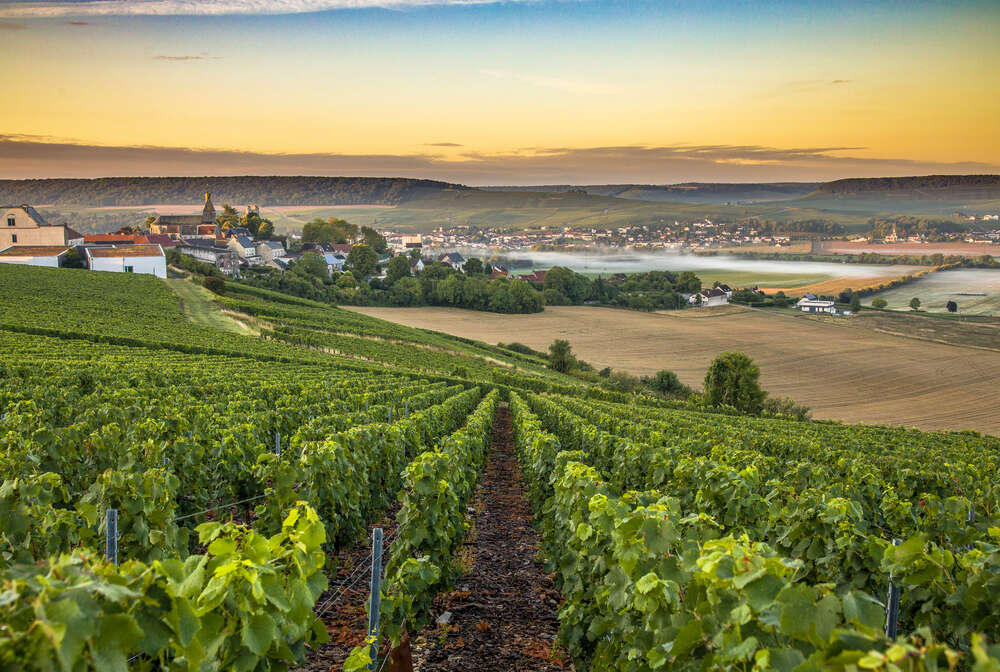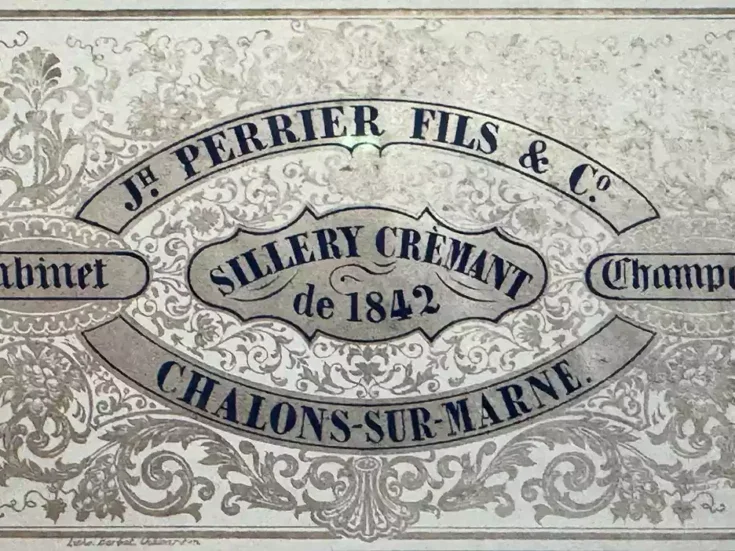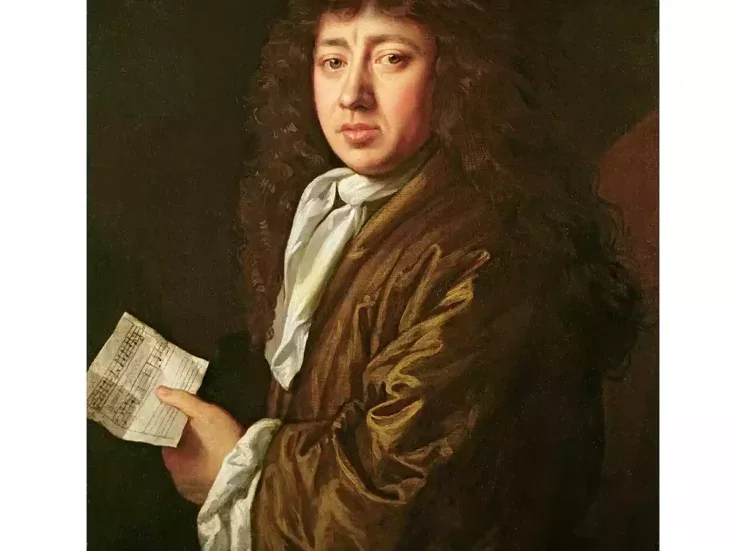
Champagne, a region not always known for its environmental sensitivity, is at last embracing sustainable practices, with a wide range of high-quality organic and biodynamic wines now available, says Essi Avellan MW after an impressively varied tasting shared with Sarah Marsh MW and Anthony Rose.
Champagne has not been able to boast a particularly green image, but new winds are blowing at an accelerated pace.
The era from the 1970s until the turn of the millennium is not one on which the Champenois look back longingly when it comes to viticulture. The overexcited use of chemical products marked a period that damaged the soils and let many good, natural practices be forgotten. The sad evidence of soil neglect persists right up to today. Turn some topsoil in even the most prestigious grand cru vineyards, and colorful pieces of plastic will pop up. Boues de ville—urban waste—was used as fertilizer in the vineyards from the 1970s onward, until it was finally banned in 1998. In the same era, increased yields pushed for the adoption of chemical tools such as herbicides, fungicides, and insecticides.
A welcome new era started at the turn of the century, when the Comité Champagne conducted in-depth research into the industry’s environmental impact and launched an ambitious environmental plan. The results since 2000 show, for example, a 20 percent reduction in carbon emissions per bottle and a 50 percent reduction in the use of both phytosanitary products and nitrogen fertilizers. A regional sustainability certification, VDC (Viticulture Durable en Champagne), was introduced in 2014. Today, 15 percent of the vineyard area falls under the certification, and ambitions are much higher for the future.
In 2018, the Comité Champagne announced a zero-herbicides target. It now appears, however, that this will not be written into the region’s rulebook and will be merely the recommended practice. So, there is not yet a revolution in the region, which is battling with supply issues due to booming demand and two short harvests, 2021 having been particularly challenging for viticulture.
Even so, many houses continue on the greener path, with, for example, the LVMH properties, Bollinger, and Perrier-Jouët having banned herbicides in their own vineyards altogether. As important as their example is, it is the thousands of individual growers who must adopt the new regime, so that purchased grapes are also herbicide-free.
Organic and certified
Even if organic farming used to be very much out of fashion, Champagne had its pioneers, Jacques Beaufort, Jean Bliard, Serge Faust, Roger Fransoret, Georges Laval, Yves Ruffin, and Pierre Thomas being listed by the Association des Champagnes Biologiques as the initial seven practitioners of organic viticulture.
Compared to many other wine regions within France and beyond, Champagne’s organic production remains low even today. What is encouraging, however, is the exponential pace of growth. In 2000, organic farming was negligible, at 64ha (158 acres). By 2017, the area had already grown to 867ha (2,142 acres), of which 256ha (633 acres) were in conversion. The 2021 figures show a total of 2,751ha (6,798 acres), of which 1,790ha (4,314 acres) are in conversion, representing roughly 8 percent of the area. The leading organic vine grower is Louis Roederer, whose certified 115ha (285 acres) represent nearly 50 percent of its vineyard holdings and 12 percent of Champagne’s totality of certified vineyards.
Even if other négociants have yet to go as far as Louis Roederer, many are cultivating a part of their vineyards organically and producing organic Champagnes; among them are Besserat de Bellefon, Canard-Duchêne, Drappier, Joseph Perrier, and Lanson. A house that has a particularly strong commitment to organic and biodynamic cultivation is Leclerc Briant, whose entire 14ha (35-acre) holdings follow both practices.
Most of Champagne’s organic production is, however, realized by its numerous small growers, the number of domaines growing grapes organically or in conversion having risen to 598. The Aube department is proving particularly dynamic in this field, with 481ha (1,188 acres) cultivated organically, of which 238ha (588 acres) are in conversion.
The pioneering biodynamic efforts of Champagne Fleury must be noted, but shining stars of organic Champagnes today also include André Beaufort, Vincent Couche, Val Frison, Olivier Horiot, Marie-Courtin, Piollot, and Vouette & Sorbée. In the Marne, much is owed to Yves Ruffin and De Sousa for their early efforts, but today the ever-expanding group of producers also includes important names like Emmanuel Brochet, Pascal Doquet, Benoît Lahaye, and Georges Laval.
Still, one must bear in mind the numerous growers who practice organic or nearly organic methods, reverting to non-organic methods only in extreme situations in order to save the crop. For the sake of clarity, our tasting did not include such producers, only certified ones. Some of them go even further, following biodynamic methods.
Tasting organic and biodynamic Champagne
Sarah Marsh MW, Anthony Rose, and I had a good number of samples to savor. We blind-tasted 37 wines, then Anthony tried on his own the late arrivals from Robert Barbichon, Pascal Doquet, Georges Laval, and Vouette & Sorbée. It is a shame that the wines from these rather iconic producers could not be tasted by the whole panel; it of course somewhat skews the results, which were already quite a mixed bag.
I have seldom taken part in a tasting whose results are so difficult to interpret. As Anthony points out, there was a much wider divergence of opinion between the three tasters than usual. There was a considerable—more than ten-point—difference between the highest and the lowest individual scores for five wines. Sarah gave 98 points to Duval-Leroy’s Précieuses Parcelles Cumières 2005, whereas I wasn’t impressed and gave it 86 points. For the Colette Bonnet Noir Essentiel No.2016, our positions were reversed, with me being generous at 93 points and Sarah showing disagreement with her 80 points. For Leclerc Briant Réserve Brut NV, the main discrepancy was between Anthony’s (86-point) and Sarah’s (96-point) assessments.
Overall, Sarah scored most highly, with an average of 90.9; Anthony was not far behind with his 90.3 (for the wines we blind-tasted together). My average was 88.8. Thus, the wines scored well, despite our personal preferences mixing the bag. This is understandable, in that the tasting offered a variable bunch of wines from Champagne’s different corners, Vintage and Non-Vintage, and blends as well as varietal and single-vineyard wines. As most Champagnes came from growers, we were treated to a wealth of individual characters and expressions.
As Anthony suggested, the notable use of oak and very low dosage levels were clearly dividing the tasters. Even if organic and biodynamic production allow for the use of sulfur dioxide, many producers seek to avoid or minimize additions, an approach that can compromise ageworthiness and lead to premature oxidation, especially when combined with low or no dosage. This we certainly encountered in the tasting. We couldn’t, however, detect a pattern of the biodynamic wines doing notably better or worse than the ones carrying only an organic certification.
Overall, this tasting was a celebration of the diversity of styles in Champagne. Our top ten included several blancs de blancs but also a pure Pinot Noir, a pure Meunier, and even a blend of all seven of Champagne’s authorized grape varieties. My over-90-point wines included some usual suspects—Champagnes from Larmandier-Bernier, Mouzon-Leroux, Piollot Père & Fils, and Val Frison. Yves Ruffin’s wines also did consistently well for me, all three tasted cuvées getting 90 points or more. I was particularly delighted to discover Carkonnia blanc de blancs from Antoine Chevalier, the rising star from Vitryat.
A great selection of organic and biodynamic Champagnes is already available, as this tasting proved. Even more exciting is what is still in the pipeline. Given that 1,790ha (4,314 acres) are in conversion—a process that lasts three years—and that the wines will age for a minimum of two years prior to release, we can look forward to many more organically certified Champagnes.
The top five: The best of organic and biodynamic Champagne
Champagne L’Angélique (Sébastien Mouzon / Mouzonn Leroux) Les Fervins 7 Cépages Verzy Grand Cru Brut Nature 2016 (organic; 12.5% ABV) |93
EA: Deep lemon color. Lovely tones of complexity from maturation on the layered nose. Brioche, spice, and dried fruits. The palate comes across as more austere, after the promising aroma-bomb of a nose. Tight with tension, but the fruit could show more of its charms. | 90
SM: Creamy frangipane aroma. Indulgent and sumptuous but refined at the same time. Opulence and restraint combine on the palate. It is rich and full-bodied, with supple muscularity. Notes of stem ginger and cumin are enhanced with a touch of aromatic cigar box. I love the alluring aromatics and the burly freshness and sheer vitality of this wine. | 96
AR: There’s a pale lemony hue to this fizz, which hits its stride immediately with a fresh, stylish aromatic character derived both from toasty autolysis and fruit, a character that continues in its bright, fresh-fruit flavors carried on a fine mousse of bubbles that dissolve in a fizz of good vinosity; a textured fizz, in other words, which is also a wine of vibrant, full flavor, combining orchard fruit with a succulently tangy dryness, all beautifully balanced and refreshingly, saltily dry on the finish. | 94
Champagne Antoine Chevalier Carkonnia Blanc de Blancs Extra-Brut 2017 (biodynamic; 12% ABV) |93
EA: Bright lemon color. A beautifully toasty nose, with a flick of vanilla meeting stylish oaky whiffs over a very clean fruit profile of ripe apple, sweet lemon, and yellow plums. A really promising nose. Super-creamy and caressing on the palate, with the softest mousse. Great fruit intensity, which goes perfectly hand in hand with the wine’s stylish, bright, and crunchy acidity. | 93
SM: Full and rich, a brioche, buttery aroma, with a hint of mocha. Opulent and engaging. The velvety, rich mousse is sliced with freshness. There is a firm, crisp backbone, enveloped in generous, savory nuttiness. Nicely balanced, quite tangy and tart on the finish. | 93
AR: A youthful pale gold in color; the aromas are fairly subdued but show a gentle degree of grilled nuttiness and autolytic toastiness and savory underpinning; there’s an appealing creaminess of mousse, releasing a full-flavored richness of orchard-fruit purity, in a very well-balanced fizz of some energy and freshness. Very well made indeed. There’s a lot to like here, not least in its depth of fruit balanced by a satisfyingly tangy dryness on the finish. | 93
Champagne L’Angélique (Sébastien Mouzon / Mouzon Leroux & Fils) Verzy Grand Cru Blanc de Blancs Brut Nature 2016 (organic; 12% ABV) |92
EA: Medium-deep lemon color. The first approach is appley, with a touch of earthy evolution, flor yeast, and meadow. Rich palate, with good width and a smooth texture. The finish could go longer. | 87
SM: Succulent and caramel—what a golden and enveloping nose. A come-hither aroma. This attacks the palate. Strident and punchy. Firm, tight, and well-integrated mousse. Good backbone here. Intense, athletic, and burly. Darker notes of roasted coffee bean and roasted cumin. I like the hint of bacon fat on the assertive finish. | 96
AR: Pale lemon in color. There are appealing notes of white chocolate and grilled almond in the aroma, autolysis working its magic with a light veneer of toastiness, too, followed in the mouth by an expansive mousse of bubbles. This delivers a rather unexpected orchard-apple dryness and bite, whose lean, almost-tart streak of crisp acidity stabs at the tongue in an almost aggressively textural shift of emphasis. It’s a tad austere, but lovers of acidity—like me—will enjoy this style. | 92
Champagne L’Angélique (Sébastien Mouzon / Mouzon Leroux & Fils) Verzy Grand Cru L’Ineffable Blanc de Noirs Extra-Brut NV (organic; 12% ABV) |92
EA: Deep lemon-gold. Softly fruity, pretty, yet finely nuanced on the nose. The palate does not come with quite such charms, remaining a little austere, but there is still a fine acidity and crisp fruit to it. | 87
SM: Intense aroma. Freshly baked cinnamon buns with a dose of anise. There are appetizing fresh coriander and licorice notes. Vibrant on the attack. Fine, biscuity, lightly yeasty, and miso characters. It has a lithe muscularity. Tight-knit mousse. Savory and sappy persistence. | 93
AR: Mid-gold; subtle and alluring in aroma, all the elements there but not showily; rather, hovering in the background. And it delivers, the background elements coming stealthily to the fore in an elegantly textured, fleet-of-foot fizz, whose textured cushion of bubbles contains delightful flavors of crunchy berry and light toast, carried through to a buoyant dryness, whose salty acidity adds an extra dimension to a very classy fizz. | 95
Champagne Barrat-Masson Nuances de Carnoie Brut Nature NV (organic; 12.5% ABV) |92
EA: Deep lemon color. Sweet yellow-apple fruit, with pineapple and pear drops. Also round and sweetly fruity on the palate. Long, straightforward, juicy length, on the tart side. | 87
SM: Perky, green-apple and sherbet aroma. Upright and quite salty. Silky glide into the palate. It’s streamlined and has a ribbon of lively, salty acidity and a delicate, finely detailed mousse. This shows some finesse and layering, and a pure, well-sustained finish. Rather delightful. | 95
AR: A youthful pale gold in color; this is immediately appealing in its complexity and freshness of aroma, suggesting, at first sniff, a really well-put-together fizz. It’s equally delightful when you taste, a full-flavored, rich mousse of bubbles, expansive in texture, with good vinosity of fruit in the apple and stone-fruit spectrum. A smart, stylishly dry fizz, with a zesty energy that grabs your attention with a balance that brings a smile to your face. | 93
This article appears in the 18 Nov 2022 issue of the New Statesman, The World of Fine Wine Issue 77






